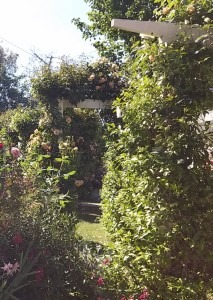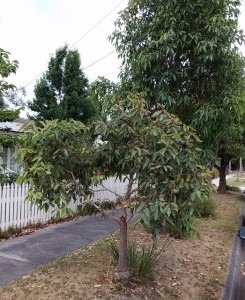In Glen Waverley, Melbourne, a committed gardener has created what many might view as a fairly traditional garden – white picket fence and roses – that is lovingly cared for using sustainable practices. It is now a show garden which has been open to the public in SGA’s Open Gardens and Tours program and previously with Open Gardens Australia. It is also a destination for the Victorian Salvia Study Group and the Heritage Rose Society of Victoria. It is insect and bird friendly as well as containing many edible plants.
When Terry moved into her house 21 years ago, there was lawn in both front and back areas, the inevitable Hills Hoist, dead trees, blackberries, plum, lemon and apricot trees. The lemon tree, Japonica camellias, a rhododendron and a flowering Prunus remain with the lemon tree producing admirable 500 lemons per year. In the front garden all that remain are a Callistemon viminalis and a flowering cherry. A new apricot and other fruit trees have since been planted. Tall ornamental pear trees help provide summer shade on the north of the house and the lawn has disappeared.
 With a passion for roses, Terry has over 75 different varieties some of which climb romantically over arches. Others are dotted throughout in deep garden beds. Similarly over 65 different Salvias peep out from every available spare space. Together with various ground covering plants this means that there is very little bare earth. The salvias, in particular, make the garden attractive to a wide range of insects, including bees, praying mantis, ladybirds, hover flies, dragon and damsel flies, and parasitic wasps especially since no chemical sprays are used, allowing these beneficial insects to control the pests. The latter lay their eggs in the aphids and the larvae, when hatched out, eat the aphids from the inside. She avoids removing aphids from the roses since they provide the “food” for the wasps.
With a passion for roses, Terry has over 75 different varieties some of which climb romantically over arches. Others are dotted throughout in deep garden beds. Similarly over 65 different Salvias peep out from every available spare space. Together with various ground covering plants this means that there is very little bare earth. The salvias, in particular, make the garden attractive to a wide range of insects, including bees, praying mantis, ladybirds, hover flies, dragon and damsel flies, and parasitic wasps especially since no chemical sprays are used, allowing these beneficial insects to control the pests. The latter lay their eggs in the aphids and the larvae, when hatched out, eat the aphids from the inside. She avoids removing aphids from the roses since they provide the “food” for the wasps.
Having many insects in the garden means that birds have a ready meal. To further foster natural insect control, Terry has planted edible plants and herbs among the shrubs. She is particularly keen on Society Garlic Tulbaghia violacea which looks spectacular and produces edible leaves and flowers. It is reported to help deter aphids from roses and prevents scale and sooty mould on trees.
 The nature strip boasts eucalypts and salvias too.
The nature strip boasts eucalypts and salvias too.
There are three water tanks, ranging in size from 2000 to 22,700 litres linked to a drip irrigation system. The largest tank is cleverly hidden in the back corner behind lattice and screening plants. To augment this water supply Terry uses grey water from the laundry and bathroom as well as run-off from the evaporative cooling system. Other materials, such as volcanic rocks and lawn clipping get recycled too. The use of permeable paving materials with stepping stones and minimal concrete helps with water penetration.
Fertility is augmented by application of aged sheep manure, pea straw mulch, compost in the planting holes for new plants. Terry also uses other fertilisers like Seamungus (made from fish, seaweed, manure and humic acid). It is registered as organic and is rated by SGA as having low environmental impact, Sudden Impact for roses and fruit trees (made from composted materials and boosted with minerals and rated by SGA as medium environmental impact) and potash.
It is clear that a very attractive garden that appeals to the conventional and well as the sustainable gardener can be created. It is a joy to both the owners and passers by
List of edible plants
| FRUIT TREES | VEGETABLES/HERBS | OTHER EDIBLES |
| ‘Cot N Candy,’ Apricot x Plum Nectarine Ballerina apple trees Granny Smith apple tree Lisbon Lemom Damson Plum Blood Orange Dwarf Orange Dwarf Peach Cumquat Ruby Grapefruit Feijoa Strawberry Guava Golden Peach Lemon and Lime Verbena Tamarillo Elderberry tree Columbian Lime tree Fig tree Pomegranate |
Society garlic
|
Bay tree Native raspberries Raspberries Strawberries Alpine Strawberries Thornless Blackberry Loganberry Rhubarb Violets |
Related Articles:
Managing Rats with IPM
“You dirty rat!” This phrase embodies the frustration many feel towards rats in the garden. These uninvited guests seem ever-present, scuttling along…
Pest Alert: Polyphagous Shot-Hole Borer (PSHB)
The Polyphagous shot-hole borer (known as PSHB; Euwallacea fornicates) is a pest first detected in Australia 2021 in metropolitan Perth. Native to…


